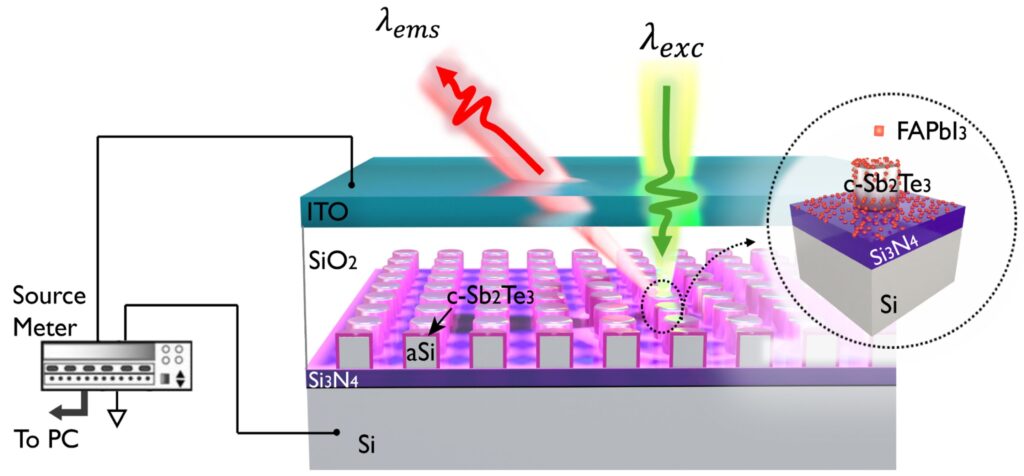The ability to control the color, or emission wavelength, of light from quantum sources is central to the development of secure quantum communication networks and photonic-based computing. However, most systems capable of tuning quantum light require extreme conditions, for example, high voltages, strong magnetic fields, and even cryogenic environments.
A new study led by Associate Professor Dong Zhaogang from the Singapore University of Technology and Design (SUTD) has found a way to achieve substantial wavelength tuning at ambient conditions using tiny, tunable nanostructures and low-voltage electrical control. This discovery is published in Advanced Materials in a paper titled “Electrically tunable and modulated perovskite quantum emitters via surface-enhanced Landau damping”.
Central to the study is a hybrid system made of perovskite quantum dots (QDs) and nanostructured antimony telluride (Sb₂Te₃), a phase-change material with unusual optical and electronic properties. Associate Professor Dong’s team was able to achieve a remarkable shift in light emission energy of over 570 meV, significantly surpassing previous reports where only minor adjustments were possible.
“Antimony telluride is a versatile material,” explained Associate Professor Dong. “It supports interband plasmonics and can switch between amorphous and crystalline phases, which allows us to control how it interacts with light and electrons. When we combine it with high-efficiency perovskite QDs, we’re able to unlock new behaviors in light emission.”
One of the key mechanisms supporting the breakthrough is a physical process known as surface-enhanced Landau damping. In this context, tiny resonances on the surface of crystalline Sb₂Te₃ nanodisks generate high-energy electrons—so-called hot electrons—when illuminated by light. These hot electrons are then injected into nearby perovskite QDs, changing the energy levels from which they emit light. This leads to a noticeable change in the color of the emitted light, which has been difficult to achieve at room temperature until now.
“Landau damping essentially allows us to convert collective oscillations into useful electrical energy at the nanoscale,” said Associate Professor Dong. “That energy can then drive changes in the QDs, giving us control over the light they emit. This mechanism is central to how we achieve such a large shift in wavelength.”
More importantly, the team’s design is not just passively tunable. When a small DC voltage is applied, they are able to control the intensity and wavelength of the quantum emission dynamically. In particular, a voltage sweep from –4 to +4 volts resulted in a 22-fold increase in emission intensity, alongside a modulated shift in emission energy. This low-power electrical tunability makes the platform especially attractive for integrated photonic circuits.
While earlier studies had attempted to couple quantum emitters with nanoantennas to adjust emission wavelengths, the scale of tunability had remained modest, typically no more than 10 to 20 meV. Associate Professor Dong’s team achieved an order-of-magnitude improvement.
“We observed a spectral shift from around 750 to 570 nanometers, one of the largest ever reported for QDs in such a platform. It’s a compelling proof-of-concept for the future of reconfigurable quantum light sources,” he added.
The system’s versatility also stems from the unique phase-change behavior of Sb₂Te₃. When in its amorphous form, the material’s atomic disorder inhibits hot-electron injection, resulting in little or no tuning. But once crystallized, the structured surface supports efficient energy transfer to the QDs. This reversible phase change offers a built-in switching function, controlled either thermally or optically, that could enable the development of programmable light sources in next-generation devices.
Looking ahead, the team plans to refine their work further by targeting single-photon emitter sources. They aim to develop precise, electrically reconfigurable systems that can enable secure quantum communication even in daylight, where background noise typically interferes with photon detection.
Said Associate Professor Dong, “We anticipate it will impact real-world applications significantly. We’re talking about photonic devices that can adapt to different frequencies on demand, potentially improving the scalability and performance of quantum communication systems. It’s a step closer to practical, integrated quantum photonic circuits.”


